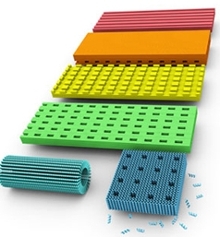
Researchers have achieved 32 different–shaped crystal structures using the DNA–brick self–assembly method.
Credit: Harvard's Wyss Institute
DNA bricks keep getting larger. In 2012, a team of researchers at Harvard described their ability to make self-assembling structures –made completely out of DNA — that were about the size of viruses (80 nanometers across).
Now they’re scaling up, making bricks that are 1000 times larger and getting close to a size that could be barely visible to the naked eye.
The advances were reported in Nature Chemistry.
Who: A team of researchers at the Wyss Institute at Harvard led by Peng Yin, and including Yonggang Ke, PhD, now an assistant professor in the Wallace H. Coulter Department of Biomedical Engineering at Georgia Tech and Emory University.
At Emory, Ke and his team are continuing to design 3D DNA machines, with potential functions such as fluorescent nanoantennae, drug delivery vehicles and synthetic membrane channels.
How: The DNA brick method uses short, synthetic strands of DNA that work like interlocking Lego® bricks to build complex structures. Structures are first designed using a computer model of a molecular cube, which becomes a master canvas. Each brick is added or removed independently from the 3D master canvas to arrive at the desired shape. The DNA strands that would match up to achieve the desired structure are mixed together and self assemble — with the help of magnesium salts — to achieve the designed crystal structures.
“Therein lies the key distinguishing feature of our design strategy–its modularity,” Ke says. “The ability to simply add or remove pieces from the master canvas makes it easy to create virtually any design.”
What for: As part of this study the team demonstrated the ability to position gold nanoparticles less than two nanometers apart from each other along the crystal structure — a critical feature for future quantum computational devices and a significant technical advance for their scalable production.
